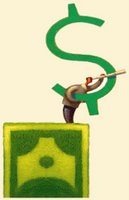Will The Prime Rate Remain at 3.25% for the Rest of the Year?
 The Federal Reserve (The Fed) has been doing all it can to boost the economy, from lowering short-term borrowing rates to record-low levels, to buying Treasury and mortgage-backed securities. But the Fed can only do so much. In fact, despite the Fed’s efforts, the economy is still sputtering at best, and may be headed for another downturn at worst.
The Federal Reserve (The Fed) has been doing all it can to boost the economy, from lowering short-term borrowing rates to record-low levels, to buying Treasury and mortgage-backed securities. But the Fed can only do so much. In fact, despite the Fed’s efforts, the economy is still sputtering at best, and may be headed for another downturn at worst.And that’s why the Prime Rate will remain at 3.25% for the rest of 2010. The Fed isn’t going to do anything to hinder the already weak-kneed economy, and therefore won’t raise the cost of borrowing until economic growth, the employment situation and inflation are all looking much better than they are today.
So how did Prime drop to 3.25%, a level not seen since 1955?
At the end of 2008, in response to the worst banking crisis in generations, and in a futile effort to stave off what would become the Great Recession, the Fed lowered it’s cardinal short-term interest rate, the target federal funds rate, to a range of 0% - 0.25%, which is essentially as low as it can go. This, in turn, caused the US Prime Rate to drop to 3.25%. Since 1994, the United States Prime Rate has been pegged to the fed funds target rate. Calculating Prime is easy: all you need do is add 3 percentage points to the target fed funds rate.
American banks and financial institutions often use the US Prime Rate in the pricing of credit cards, loans and other financial products. Read the terms and conditions of a typical credit card or loan and chances are the interest rate will be variable and indexed to Prime. Not all credit cards are indexed to the Prime Rate, but the vast majority are.
For the American consumer, the fact that Prime won’t rise any time soon is very good news. It means that, for most consumers, the interest rate on existing credit-card debt will remain as low as it can possibly be. It also means that, for most, new credit-card spending will incur the lowest possible finance charges if the cardholder can’t – or chooses not to -- payoff the entire balance at the end of the month.
Labels: prime_rate_forecast
|
--> www.FedPrimeRate.com Privacy Policy <--
--> www.FedPrimeRate.com Privacy Policy -- BACKUP<-- CLICK HERE to JUMP to the TOP of THIS PAGE > SITEMAP < |



<< Home